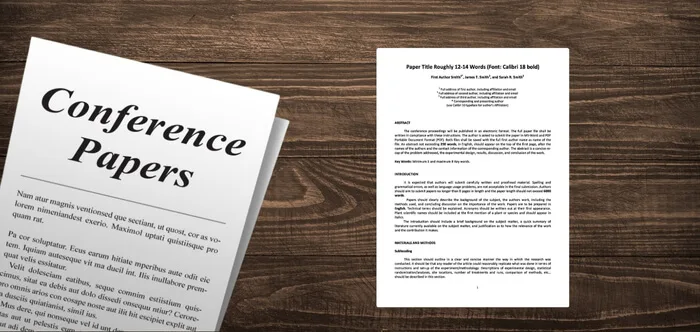In academic publications, the transition of research from one platform to another is a common but complicated process. Now might be thinking, can a conference paper be published as a book chapter?
Yes, a conference paper can be published as a book chapter, typically after it undergoes significant revisions and expansions. This evolution not only allows the research to access a broader audience but also enhances the author’s academic repertoire.
However, this transition is bound by certain protocols, including seeking permission from the original conference organizers and adhering to strict copyright laws. Interested? Join us as we dive deeper into the nuances of this process in the following article.
A Brief Overview of Conference Paper
Conference papers are essential elements in academic discourse, showcasing fresh research and innovative ideas within scholarly communities. They’re presented at conferences, offering a platform for immediate peer feedback and discussion. This real-time interaction is invaluable for refining concepts and networking with fellow experts.
Typically, these papers are concise, focusing on new findings or theories, and are often preliminary versions of more extensive research. The format encourages brevity and clarity, making complex ideas accessible to a diverse audience. They serve as a springboard for further research, often leading to more detailed publications later on.
The value of citing conference papers extends beyond the event itself; they often form the basis for future journal articles or book chapters. This progression from conference presentation to published work signifies the paper’s evolution and its impact on the field. The journey of a conference paper, from an idea to a published work, is a testament to the dynamic nature of academic research.
Book Chapter – What is it?
A book chapter is a distinct section within a larger published work, often delving into a specific aspect of the book’s overall theme. It allows for a deep dive into a particular topic, offering detailed insights and perspectives. Each chapter contributes a unique piece to the book’s comprehensive puzzle, enriching the reader’s understanding.
In academic books, chapters are typically written by different experts, bringing diverse viewpoints and expertise to the subject. This collaborative approach ensures a multifaceted exploration of the theme, enhancing the book’s academic value. Readers benefit from this blend of perspectives, gaining a well-rounded view of the topic.
Book chapters in non-academic books focus on storytelling or developing specific ideas, adding depth to the narrative or argument. They guide the reader through the book’s journey in a structured, engaging manner. This format helps in breaking down complex subjects into manageable, coherent segments, facilitating easier comprehension and a more enjoyable reading experience.
Can a Conference Paper Be Published as a Book Chapter?
Yes, it is indeed possible for a conference paper to be published as a book chapter. This transition offers the paper a broader audience and a more enduring format. However, several key factors must be considered in this process.
Revision and Expansion
Conference papers typically require extensive revision before they can be adapted into book chapters. This often involves expanding on the research and adding more detail and depth to the original work. The aim is to provide a comprehensive and cohesive chapter that aligns with the book’s overall theme. These revisions ensure the chapter contributes significantly to the field and the book.
Permissions and Copyright
It is crucial that you obtain permission from the conference organizer where the conferece paper is first published. For example you wish to publish the conference paper thats based on a conference in Canada, than you need ask for the permission of that perticular conference organizers before you publish it as a book. As It’s essential to respect and adhere to the copyright and publication policies of the conference. The content must also be carefully checked for copyright issues. In this way, legal and ethical compliance is ensured.
Alignment with the Book’s Theme
The conference paper must align with the theme and scope of the book. This involves tailoring the content to fit seamlessly into the book’s narrative or argumentative structure. The chapter should complement and enhance the overall message of the book. This alignment is crucial for the chapter’s relevance and effectiveness within the book.
Essential Steps to Transform a Conference Paper into a Book Chapter
Transforming a conference paper into a book chapter is a process that demands careful consideration and precise effort. This transformation allows the research to reach a wider audience and gain a more permanent place in academic literature. Here is a step-by-step guide to explore this journey successfully.
Step 1: Evaluate and Revise the Content
Start by critically evaluating the original conference paper. Identify areas that need expansion or deeper analysis to suit the book’s broader context. This step often involves enhancing arguments, incorporating recent research, and refining the paper’s overall structure. The goal is to enhance the paper from a conference presentation to a detailed book chapter.
Step 2: Obtain Necessary Permissions
Before proceeding, secure permission from the conference organizers. This is crucial to avoid copyright infringement and respect the intellectual property of the conference. Also, check if the conference has any specific requirements or restrictions regarding subsequent publications of presented papers.
Step 3: Align with the Book’s Theme and Structure
Ensure the paper aligns with the book’s overarching theme and structure. It may require adjusting the focus or adding content to seamlessly integrate with other chapters. This alignment is essential for maintaining the coherence and flow of the book.
Step 4: Collaborate with Editors and Co-Authors
Work closely with the book’s editors and, if applicable, co-authors. Their insights can guide revisions and ensure the chapter meets the book’s standards and style. This collaboration is vital for achieving a unified voice and perspective throughout the book.
Step 5: Peer Review and Feedback
Submit the revised chapter for peer review. Constructive feedback from peers helps in identifying any overlooked aspects and further refining the chapter. This step is critical for maintaining academic rigor and enhancing the chapter’s quality.
Step 6: Final Edits and Submission
Incorporate feedback and make final edits to the chapter. Pay close attention to details like formatting, citations, and language consistency. Once satisfied with the revisions, submit the final version for inclusion in the book, marking the completion of this transformative journey.
Benefits of Turning Conference Papers Into Book Chapters
Transforming conference papers into book chapters is a strategic move for researchers and academics. It lifts the reach and impact of their work, allowing a deeper exploration of the topic. Let’s explore the benefits of turning conference papers into book chapters.
Broader Audience Reach
Book chapters can reach a wider, more diverse audience compared to conference papers. They are accessible to readers beyond the conference attendees. Books are often integrated into academic courses, amplifying the paper’s educational impact. This extended reach benefits both the author’s visibility and the field’s advancement.
Enhanced Academic Reputation
Publishing in a book lends credibility and prestige to the author’s work. It signifies a thorough vetting and editorial process. This association with published books can bolster an academic’s profile and career. It’s a mark of recognition and respect in scholarly circles.
Opportunity for In-Depth Analysis
Books allow more space for detailed discussion and analysis. Authors can expand on their original ideas, providing richer context and depth. This depth is often not possible in the concise format of conference papers. It leads to a more comprehensive understanding of the subject.
Collaborative Opportunities
Contributing to a book often involves collaboration with other experts. This can lead to new professional connections and opportunities. It encourages interdisciplinary dialogue and idea exchange. Such collaborations can spark future joint research projects and publications.
Long-Term Accessibility
Book chapters are generally more accessible over time compared to conference proceedings. They are often available in libraries and online platforms. This longevity ensures ongoing relevance and citation potential. It allows the work to continuously contribute to scholarly discourse.
Feedback and Refinement
The process of book publication involves rigorous editing and peer review. This ensures high-quality, polished content. Authors benefit from expert feedback, enhancing their research and writing skills. It’s an opportunity for professional development and refinement of ideas.
Increased Citation Potential
Book chapters often have a higher citation potential. They are cited in future research, increasing the author’s academic influence. Higher citations reflect the work’s impact and relevance in the field. This can be crucial for funding and career advancement.
Flexibility in Content and Style
Books offer more flexibility in terms of content and style. Authors can explore creative formats and interdisciplinary approaches. This flexibility allows for a more personalized and engaging presentation of the research. It caters to a broader range of readers with varied interests.
Turning conference papers into book chapters is a strategic and rewarding effort for researchers. It not only amplifies the reach and impact of their work but also contributes significantly to the academic community and personal career growth.
Bottom Line
Our investigation into the transition from conference papers to book chapters has shown a field where academic research is restored and given greater significance. This process magnifies the reach and impact of scholarly work, offering a unique avenue for academic advancement.
In answering this central query, can a conference paper be published as a book chapter? we’ve uncovered the difficulties and rewarding outcomes of this academic venture. This transition requires careful revision, adherence to copyright laws, and alignment with the book’s theme.
The outcome of this transformation is multi-faceted, enhancing the paper’s reach, fostering collaborations, and offering deeper insights. It’s a strategic move that significantly contributes to both the academic field and the author’s career progression.







